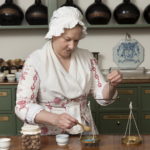The date: June 12, 1783. The place: Williamsburg, Va.
Imagine that your child suddenly develops a feverish illness. Rumors of another smallpox epidemic are whispered in the streets and your neighbor is also sick. What do you do? If word gets out that your child has caught smallpox, you and your family may be completely cut off.
Assuming you have ready money or good credit, you would likely go to an apothecary, much like the Pasteur and Galt shop on Duke of Gloucester street. There you would find a doctor, or at least a practitioner of medicine who, for a fee, would listen to your description of the symptoms, sell you a medication that might work or stop by your house and take a look.
After completing apprenticeships, William Pasteur and John Minson Galt studied medicine in England before returning to Williamsburg to practice and open their own apothecary shops in Williamsburg. In 1775, they joined forces at the Pasteur and Galt shop on Duke of Gloucester street. Besides dispensing medications, they provided surgical, midwifery and general medical services. Male apprentices and midwives also trained here.
When you look at 18th-century medicine with a 21st-century eye, the view can be very different.
In 18th-century Virginia, medical treatment took place in the home. Rough carriage travel, lack of sterile recovery environments and surgical methods made it advisable for doctors to travel to the patient’s home for treatment.
Charitable hospitals treated poor people in some large cities like Philadelphia, but conditions were not ideal and practitioners were limited in what they could accomplish.
The first successful public demonstration of the use of anesthesia was in 1846. Prior to that, surgery was performed without any numbing whatsoever. Friends and neighbors held down the patient and the surgeon worked as quickly as possible.
Smallpox could be prevented with inoculation – the practice of infecting healthy persons with mild strains of the actual disease. Leeches and bleeding were common treatments, along with the use of botanical elements such as Peruvian bark, cloves, camphor and ginger.
Besides medicinal remedies, The Pasteur and Galt apothecary shop also sold cooking spices, salad oil, anchovies, toothbrushes, soaps, candles and tobacco, much as local modern pharmacies do today.
If you look around the apothecary shop on Duke of Gloucester street today, you’ll see impressive original blue and white delft jars on the shelves with names that seem strange to us now. The drawers are filled with ingredients, both exotic and ordinary. These elements are pulled out for demonstration purposes – nothing is for sale.
“Eighteenth-century medical professionals knew that Peruvian Bark would help to treat the symptoms of intermittent fever, but they did not have the chemistry knowledge to isolate the active ingredient. Nor could they confirm whether the symptom of fluctuating fever was really malaria or a number of other diseases with the same symptoms.” said Sharon Cotner, an interpreter at The Pasteur and Galt apothecary shop.
Due to the rising tension and subsequent war with England, American apothecaries were forced to find alternative sources for their supplies. All trade with England was banned. America traded with the Caribbean to obtain the necessary goods, but trade was slow and unreliable. Medicines were harder to get and became more expensive.
Just as in the 18th century, treating illness today is often an inexact science. For all of our current knowledge and high-tech methods, doctors still attempt to treat symptoms and trust in the body to heal itself.
Many of the 18th–century medical treatments are still being used today. “We still set bones the same way. We still bleed for some blood diseases. The majority of medical care is still about treating symptoms.” Cotner says. “We had apprentices then, but we still do the same thing now. We just call it an internship and residency.”
“We hope in the future, medical historians will look back to our time and realize that we are doing the best that we can with what we know now. I can see a history museum in the future doing a whole exhibit on how we treated for cancer.” says Robin Kipps, interpreter supervisor.
“There may be vaccines for cancer prevention in the future. We get kids all the time that ask us what smallpox is.” Kipps says. “Hopefully we will have kids come in and ask, “What’s cancer?”

Excellent post Karen I love too much the story of traditional medicine !